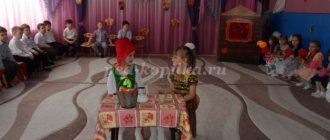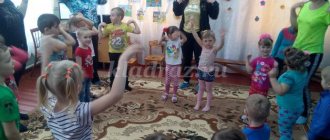Role-playing game “The Wolf and the 7 Little Goats”
Purpose : defining roles in the group, icebreaker. Time : 20 minutes. Materials : 7 pieces of paper – “kid”, 4 pieces of paper – “wolf” and “goat” (there may be different ratios: 2:2, 1:3, 3:1). Procedure: About 10 people take part in the game. The pieces of paper are rolled up and placed in a box, from where the game participants take them out when assigning roles. The number of “wolves”, “goats” and “kids” can, if necessary, vary and include all members of the group or part of them. Psychologist: “In the box there are notes on which your roles are written. You will now each take out a folded note and decide on your role. You cannot show the piece of paper to others or name your role. The “kids” stand up in a separate group. “Wolves” and “goats” are trying to get to the “kids”. The task of the “wolf” is to pretend to be a “goat” in order to get to the kids and eat it. The task of the “goat” is to convince the “kids” that she is actually a “goat”, must feed them, save them from hunger. The task of the “kids” is to jointly determine who is in front of them and decide: to let them in or not to let them in. “Kids” can ask questions and confer. If the “kids” made a mistake: they let in the “wolf” - one “kids” is considered “eaten”; they didn’t let the “goat” in - one “kid” is considered to have “died of hunger” Are the instructions clear? Let's get started."
The game allows you to determine roles in the group.
When discussing the results of the game, the participants are asked questions: (in turn to the “kids”, “goat” and “wolf”):
- How did you feel?
- Was it easy to make the decision?
To other participants:
- What did you notice?
- What screening questions could you ask?
Exercise “Tower of Babel”
Goal : aimed at developing skills for making joint decisions, strengthening team spirit, team building, and setting a common goal.
Time: 10-15 minutes. Materials : colored markers, flipchart, individual assignments prepared in advance. Individual tasks : written briefly on separate sheets, each sheet is strictly confidential for one participant. For example, “The tower must have 10 floors” - a piece of paper with such an inscription is given to one participant, he has no right to show it to anyone, he is obliged to make sure that the tower drawn together has exactly 10 floors! The second task: “The whole tower has a brown outline” is a task for the next participant. “A blue flag is flying above the tower”, “There are only 6 windows in the tower.” Procedure: The exercise is carried out in a group. The psychologist gives everyone an individual lesson and gives instructions : “Each of you has a task. Read it. There is no need to discuss or show it to others. Each of you must depict in a common picture what is written in the assignment. It is forbidden to talk or use your voice in any way. We need to draw the Tower of Babel together.”
After completing the task, discuss the results with the group and the process of completing the task:
Was it difficult to complete the task? What was the most difficult thing?
What happened in your overall drawing? Did it match the task?
Are your relationships in the group similar to what is shown in the picture?
Cards with the task in Appendix No. 2
A block of exercises to develop effective communication skills
Goal: Increasing competence in communication, developing the ability to adequately and fully perceive oneself and other people, acquiring skills and abilities that contribute to successful business communication.
.Exercises are carried out in the morning before the start of the operator’s working day in the psychological relief room. Class time is 20-30 minutes.
Exercise "Paraphrase"
Purpose and application possibilities: the exercise is aimed at developing active listening skills.
Execution time: 10-15 minutes.
Procedure: The exercise is carried out in a group.
Psychologist : “Split into pairs. One participant formulates a message on a topic. Another repeats his thought in his own words (paraphrases). Then he, on the contrary, formulates the message, and his partner paraphrases his words. We select topics for discussion based on the storyline of the work process.”
Issues for discussion:
How does this technique help in communication?
How and where can it be applied in work?
How did you feel during your opponent’s answer (understanding, misunderstanding)?
What feelings did you experience during your opponent’s answer (was it pleasant, unpleasant)?
Educational activity “Kids and the Wolf”
Educational activity " Kids and the wolf "
Target:
Educational activities with young children:
- strengthen the ability to listen carefully to a literary work;
- exercise children in walking on a limited surface; develop balance; strengthen the foot;
-learn to act rhythmically, coordinating actions with the rhythm of the poem;
-encourage independence, maintain confidence in one’s actions.
- promote the development of curiosity and activity.
— to teach children to listen to an adult’s speech, to correlate their actions with the word and with the movements of their peers.
— building emotional and trusting relationships that contribute to the full development of the child and positive self-realization of adults
— to develop in children the ability to group objects by color and shape;
- activate children's speech;
Interaction with parents:
— Involving parents in finger gymnastics
— Involving parents in joint games
— Homework for parents is to do finger exercises,
— Involving parents in artistic creativity
Equipment:
Dolls - bibabo: goat, kids, toys - wolf, bunny, sets of colorful houses and doors, laces and buttons, bowls according to the number of children with beans: red and white, bowls according to the number of children, gouache in red, blue, green, yellow, handprints, brushes according to the number of children.
Content:
Greetings.
The teacher greets parents and children and draws attention to the Bunny:
Ay, chi-chi, chi-chi, chi-chi! A hare is sitting on the stove. He plays the drum and invites you to visit!
Teacher: Guys, Bunny invites us to a fairy tale.
Once upon a time there lived a goat.
The goat made herself a hut in the forest and settled in it with her
kids.
Every day the goat went to the forest for food.
Now we're going to play goat.
Finger gymnastics “Horned goat”
A horned goat is walking ( an adult makes a “goat” from his fingers, for which you need to form a fist and put your little finger and index finger forward
);
For the little guys
Legs top-top ( here you can turn the “goat” with your fingers down, simulating walking);
Clap-clap with your eyes ( at this line you can open your hand and then clench it into a fist again 2-3 times).
Who doesn't eat porridge? ( the hand again forms a “goat”, which begins to approach the child)
Who doesn't drink milk?
I'll gore him, I'll gore him, I'll gore him! ( at this line the “goat” should get to the child and start “butting” him. You can simply touch the baby, simulating butting, or lightly tickle him).
Teacher: The goat will leave, and he tells the children to lock themselves tightly and not unlock the doors for anyone. To prevent the wolf from getting into the house and eating the kids, the door to the house must be tightly closed.
MAGAZINE Preschooler.RF
FUN in the junior group “The Wolf and the Seven Little Goats”Physical education teacher N.A. Plaksina
Program content:
- develop the child’s emotional sphere, memory, attention
- to educate children in the ability to be organized and maintain friendly relationships with peers
- consolidate the ability to run and walk, coordinating the movements of the arms and legs
- learn to land softly in jumps while maintaining balance.
Inventory: Goat costume, life-size "Wolf" , bell, massage paths, bags, hoops according to the number of children, blue fabric, magic wand.
Progress of entertainment:
Children enter the gym and are greeted by Kozochka (a teacher dressed as a goat).
Educator: Guys, look who came to us?
Children's answer...
Goat: I came to visit you from the fairy tale “The Wolf and the Seven Little Goats . Do you remember what happened to the kids in this fairy tale?
Children's answer...
Goat: You said everything correctly. The little goats did not listen to mother Goat, and they were caught by the gray wolf. So that this doesn’t happen to us, let’s practice hiding from the wolf.
(The goat invites the children to turn into kids, touches each child with a magic wand)
Game “I’ll run away from the wolf” - The goat rings the bell and the kids must run up to her to “hide from the wolf”
Goat: Well done, did you remember everything? As soon as the bell rings, the little goats should run to the Goat.
Goat: Now kids, let’s go to the river, drink some water and frolic (music from the cartoon “The Wolf and the Seven Little Goats” ).
Somehow a goat and a goat follow the goat one after another
She took the little goats into the forest.
We walked along a forest path, walking along massage paths
Behind the meadow grass. They ate succulent leaves. There are driftwood and stumps. walking between objects Suddenly the path began to twist...
The goat rings the bell: - You little goats, don’t be naughty. But quickly run to me. We need to train, all the children run to the goat so that they are not afraid of the wolf.
Goat: So we came to the river, let’s jump over it! (jumping over a river with both feet)
The goat rings the bell, all the kids run up to her.
A wolf appears (life-size toy)
Goat: Little goats - guys, don’t be afraid of the wolf, we’ll drive him away now.
(children take the bags and throw them at the wolf, the wolf hides).
Wolf: Don't be afraid of me, little goats, I just want to play with you.
Goat: Shall we play with the wolf?
Children's answer...
Game "Wolf and kids"
Each child stands in a hoop, this is the kid's house. The goat, accompanied by music and a cartoon (Oh, little goats, you guys. You are left without a mother. I’m going to the garden to get cabbage...) goes around all the houses, wags his finger, and says that no matter how much the little goats open the door, she herself “goes to the garden to get cabbage.” “ At this time, the kids come out of the houses, jump and frolic in the clearing.
Educator: We’ll go to the clearing, we’ll start jumping.
We jump, eat grass, listen to silence.
The wolf does not doze or sleep, he watches over the kids.
At the teacher’s signal, “The wolf has woken up!” - the kids run away and stand in any empty hoop, and the wolf catches up with them. The game is repeated 3–4 times.
Wolf: What agile little goats, I didn’t catch up with anyone, but I’m very tired, I’ll go and sleep (put the wolf on the bench at the exit from the gym).
The goat offers to play a game
Finger game “The goat is shaking the strings” (sitting cross-legged)
The goat winds the strings, winds them around the ball “wind the threads” on the right hand, palm into a fist The goat winds the threads, winds them around the ball! “wind the strings” on the left hand, palm into a fist
Views, views, views! “rotate our fists” I pound the beaters with my fists and clap them on my knees I nail them! I'm banging my fists against each other! palms tapping on the floor
Goat: And now, “goats” , you turn back into children and go to your group, and in order to go to the group you need to pass by the wolf and not wake him up.
Goat: You go quietly,
You won't wake the wolf.
Low mobility game “Who is quieter”
| Next > |
Progress of the game
Introductory part:
Guests come in, the children and I look at pictures of different fairy tales.
Educator: Let's say hello to the guests?
Children: Hello!
Educator: What kind of fairy tale are we going to play
?
(showing the picture “
The Wolf and the Seven Little Goats ”
)
Children: To the little kids
!
Educator: I'm now going to become a kid
.
Top top, clap clap! Have you become goats
?
Main part :
Teacher - Little Goat
: Oh! Mom left, why should we stay at home? Let's go for a walk in the forest, it's more interesting there!
Let's go to the forest to the music.
V.-K: Look? What is this?
Goats
: Cone!
V.-K: How many? And how many are there in the forest? Shall we collect cones? Only “extraordinarily”
We take one at a time so that there is enough for everyone!
(I scatter the cones and collect them in the cornice)
V. -K.: It seems I noticed someone. (I put the Wolf hat on the child
)
Who is this?
Goat: Wolf
!
(
kids ,
the wolf is scaring
)
V.-K.: I will drive away the Wolf
!
- Go away, Wolf
!
(
The wolf is not afraid )
Let's try it together? -Go away! (
The wolf is hiding , we take off
the wolf
)
V.-K: You see, when I was alone, I couldn’t cope with the Wolf
, and when we are together and there are many of us. we drove him away.
V.-K: Oh, how far we have gone from home. We have to go back. Look at the stumps! How can we get around them? (we jump over the small hoop, go around the big one)
V.-K: Look! There is a stream in front of us. What is he like?
Goat: Long, blue, wet.
V.-K.: Is it the same along the entire length? (we begin to consider from a wide place to a narrow place)
How can we get through? You can simply step over a narrow stream. Wow! How clever we are!
V.-K.: And here is our house! (the teacher comes out of the image of a kid
and puts it on the mother-goat’s arm)
Final part :
M. -K.: These are my kids
, where were you? You cannot leave home without permission! I am very glad that nothing happened to you!
Educator: That’s how the kids’
! Remember we put postcards in a box? Let's give them to our guests.
Publications on the topic:
Dramatization of the fairy tale “Merry Little Goats” in the middle group Hostess: Hello, guys! I'm glad to see you in my hut! Today is a holiday - cabbage. On this day they begin to chop cabbage. Cabbage.
Tatyana Yuryevna Lyudmila Anatolyevna Irina Nikolaevna Photo report on the play “The Wolf and the Little Goats” The play was staged with senior preschool children.
Game-dramatization “The Wolf and the Seven Little Goats” Game-dramatization based on the fairy tale “The Wolf and the Seven Little Kids” Purpose: using the example of the theatricalization of the fairy tale, to form children’s ideas about the rules of safety.
Integrated lesson in the second junior group “The Wolf and the Seven Little Goats” Integrated lesson in the junior group “The Wolf and the Seven Little Goats” Purpose: To develop children’s ability to understand the characters’ characters when listening.
One of the most fun and vibrant folk holidays is on the doorstep - Maslenitsa. This is a wonderful opportunity to introduce and introduce children to traditions.
Summary of a physical education lesson in the second junior group on the fairy tale “The Wolf and the Little Goats” Synopsis of a physical education lesson in the 2nd junior group on the fairy tale “The Wolf and the Little Goats” ___ Objectives: 1. Teach.
Lesson summary “Wolf and kids” Lesson summary on the topic “Wolf and kids” Vdovidchenko Nelly Vasilievna For younger children. Objectives of the lesson: Continue to introduce.
Joint educational activities of the teacher and children of the younger group
using gaming technology



